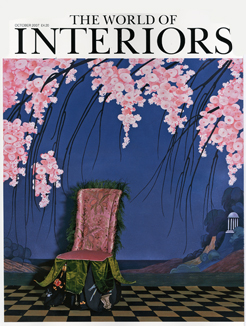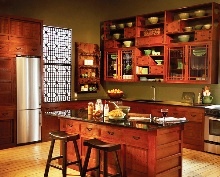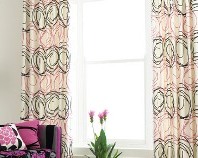Matters of Taste
 September 18, 2007
September 18, 2007 Irwin Weiner - Many years ago, I was walking through the Kips Bay Decorator Show House in New York with a group of design colleagues. We were doing our annual stroll through this famous show house, trying to convince ourselves that this was America's interior design equivalent of Paris Fashion Week.
We simultaneously admired and bashed the work (and designers), and that was the most fun of the day. The pinnacle for us was the room with the colors that matched the M&M's. A designer had purchased packs of M&Ms and selected the colors that mirrored the decor. Of course stores now sell M&Ms and other candies in rainbow hues, but back then it was quite unusual.
 The M&Ms had our group divided right down the middle. Some thought it whimsical, coordinated, and detailed. Others thought it was tacky and over-decorated. For the record, I was a member of the latter group. I thought it was totally tasteless.
The M&Ms had our group divided right down the middle. Some thought it whimsical, coordinated, and detailed. Others thought it was tacky and over-decorated. For the record, I was a member of the latter group. I thought it was totally tasteless.
Interior design and "home style" is a relatively new and expanding industry in the United States. In the last few years, the housing and Internet booms have made home design accessible to a broader audience. Home makeover television shows, Internet marketing, cheap imported furniture at big box stores, and now-hard-to-get home improvement loans brought decorating smack into the epicenter of the average American home.
That's good and bad news. The good: more people are aware of interior design. The bad: the quality is largely atrocious. Many have embraced the Do It Yourself trend, and most of what I see people doing for themselves should end up anywhere but in someone's home.
Interior design is like a new toy. Most people can't get enough of it, they love to keep playing with it, and they don't have much experience with it.
Now add people with money to professionally decorate to this trend. They, like the masses, can't get enough of interior design (the new toy), they love to keep playing with it, and they don't have much experience with it. Remember this formula: People With Lots Of Money [Do Not Necessarily, and Quite Rarely, Equal] People With Good Design Taste. If Donald Trump was my decorator, he'd be fired.
Compounding bad taste is the wrong-headed notion that any high-end design purchase has to be the "right choice." Why must clients have certainty that something is right, absolute, and It? Part of the reason is that they have no experience or knowledge about what is good and bad design to begin with. They don't have the right tools to Do It Themselves or have confidence in their choices. That makes it difficult for them to weed out the many, many bad possibilities from the few good possibilities available.
One client drove me so crazy not being able to make up her mind about a purchase, that I asked her how she chose a husband. She answered, "There was much less choice." Most of my clients can relate to this.
Changing design styles also compound the choice problem for clients. Twenty-five years ago, styles were quite contemporary; ten years ago, they were more traditional; now we're swinging back to contemporary.
Seasons are also confusing for clients. Commercial furniture stores show cotton-covered upholstery with light and airy patterns in the summer and fall colors in the autumn. It always amazes me how difficult it is to sell a heavyweight fabric to a client in summer.
But back to the "right choice" topic. It doesn't just apply to a single purchase, but extends to the entire decorating project. There is no one "correct look" or a "right way" to design a home project. If there did exist such a thing, there would be only one interior design magazine and it would feature only one house.

Imagine if you had unlimited financial resources. It might be ideal to buy everything you ever dreamed of to complete your interior -- right down to the color-coordinated candy bits. But then again, even if you worked with the most expensive and amazing interior designer, would you have a good interior when you were done?
For me, a "good interior" gives me the same goosebumps I get when listening to a great piece of music, seeing a wonderful film, admiring a beautiful painting, or gazing out at gorgeous natural scenery. I've spent many years trying to analyze what I could create that might evoke the goosebumps, show good taste, and be worthy of the mantle "good design." I can totally recommend that you pick up a copy of The World of Interiors magazaine, a British shelter piece that gives me goosebumps each time I study its pages. I love it, and it can give you much inspiration for your high-end design projects.
Color-coordinated candies will not lead you to good taste or good design. Instead, consider this advice:
1. Go for unusual architectural elements. I love spaces with good bones. High ceilings, big windows, sweeping staircases work well for me. Fussy architectural elements like moldings and columns are not as important and are generally applied ornament.
2. Focus on the essence of the space, clearly defined. I think that most times if you have a space that is large in scale to work with, then the rest is easy.
3. Fill your space, but do so wisely. Fill rooms with whatever you like, but try to always keep things unusual and unique. Look at elements for what they are -- for their shape, color, and design -- and not for their context. It doesn't matter if what you buy is dated, inexpensive, or priceless. It's only important if it's incredibly interesting.
4. Grow and evolve your interior. I don't see myself as a "collector." I am an "accumulator." You should be too. Continue to accumulate the elements that fill each of your rooms, then carefully curate (weed out the unwanted, add the wanted). Always be looking and learning. It helps if you have a great decorator at your side to help you learn, too. Find one with great experience, a good sense of humor, a breadth of knowledge, and good taste -- and then trust her or him to do a great job for you.
Remember that it takes a lifetime to decorate. The process should never stop. You're living in a breathing, growing, changing environment, not a museum. It will never be completed, you'll always run into unique pieces to add to your accumulations, and you'll learn to live in an evolving state of design.
My wish for you is that you enjoy the journey, and fall in love with your space.
And I also wish you goosebumps.
What do you think "good taste" means? If someone's not born with it, do you think they can acquire it? Thank you for your post . . . .
Photo Credits: My M&MS, The World of Interiors.
 World of Interiors,
World of Interiors,  decorating,
decorating,  taste,
taste,  tips in
tips in  Irwin Weiner,
Irwin Weiner,  contemporary,
contemporary,  interior design
interior design 












